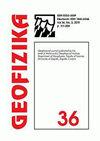Biexponential decrease of PAR in coastal waters (Northern Adriatic)
IF 1.1
4区 地球科学
Q4 GEOCHEMISTRY & GEOPHYSICS
引用次数: 1
Abstract
The attenuation coefficients of photosynthetically active radiation (PAR) were extracted from the vertical profiles of PAR in coastal waters (the Gulf of Trieste, Northern Adriatic). The vertical profiles were collected roughly twice per month from July 2011 to December 2015, and the PAR values just above the sea surface were compared with the PAR data measured on a buoy.This research supports the nonlinear fit with the biexponential expression for the dependence of PAR with depth, yielding a much better match with the data than the fit with a mono-exponential expression. However, another reasoning for biexponential attenuation is because it functions as a solution for a homogeneous differential equation of a second order. The method for estimating the water type is offered with an analysis of the attenuation coefficients of PAR. It was found that for a particular location (the Gulf of Trieste), the attenuation coefficient in a mono-exponential decrease of PAR is 0.19-0.21 m-1, while for a biexponential decrease of PAR, the coefficient of the long-range attenuation is 0.12-0.14 m-1 and that of short-range attenuation is 0.8-0.9 m-1. This leads to the conclusion that most water columns match coastal water type 1, while the surface layer is represented by coastal water types 7 or 9. From the estimate of the water types, the coefficients of downward irradiation were inferred as 0.19 m-1∓0.01 m-1 (long-range attenua-tion) and 3.0 m-1∓0.7 m-1 (short-range attenuation). These coefficients can determine the heat source inside the water column.沿海水域标准杆数的双指数下降(亚得里亚海北部)
从沿海水域(亚得里亚海北部的里雅斯特湾)标准杆数的垂直剖面中提取了光合活性辐射(标准杆数)的衰减系数。从2011年7月到2015年12月,每月大约收集两次垂直剖面,并将海面上方的标准杆数值与浮标上测量的标准杆数数据进行比较。本研究支持标准杆数与深度相关性的双指数表达式的非线性拟合,与单指数表达式的拟合相比,与数据的匹配要好得多。然而,双指数衰减的另一个理由是,它起到了二阶齐次微分方程解的作用。通过对标准杆数衰减系数的分析,提出了水类型的估计方法。发现对于特定位置(的里雅斯特湾),标准杆数单指数下降时的衰减系数为0.19-0.21 m-1,而标准杆数双指数下降时,长程衰减系数为0.12-0.14m-1,近程衰减系数则为0.8-0.9m-1。这导致了这样的结论,即大多数水柱与海岸水类型1相匹配,而表层由海岸水类型7或9表示。根据对水类型的估计,向下辐射的系数推断为0.19m-1∓0.01m-1(长程衰减)和3.0m-1 \87.23; 0.7m-1(短程衰减)。这些系数可以确定水柱内部的热源。
本文章由计算机程序翻译,如有差异,请以英文原文为准。
求助全文
约1分钟内获得全文
求助全文
来源期刊

Geofizika
地学-地球化学与地球物理
CiteScore
1.60
自引率
0.00%
发文量
17
审稿时长
>12 weeks
期刊介绍:
The Geofizika journal succeeds the Papers series (Radovi), which has been published since 1923 at the Geophysical Institute in Zagreb (current the Department of Geophysics, Faculty of Science, University of Zagreb).
Geofizika publishes contributions dealing with physics of the atmosphere, the sea and the Earth''s interior.
 求助内容:
求助内容: 应助结果提醒方式:
应助结果提醒方式:


